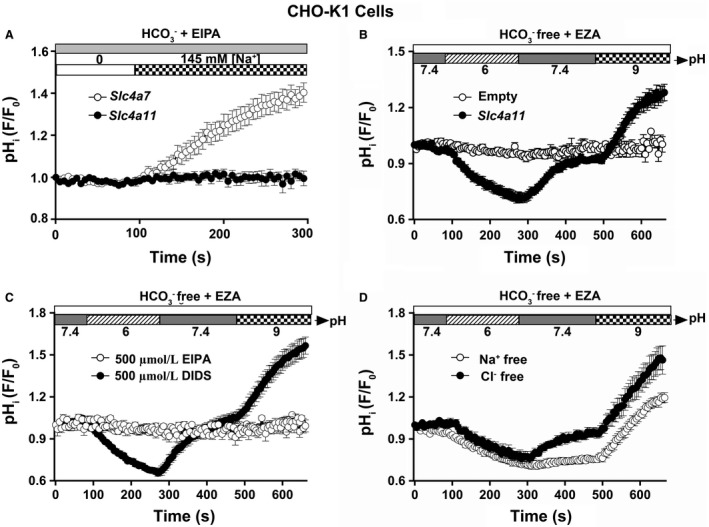Figure 5.

Mouse Slc4a11 mediates H+‐OH− transport in CHO‐K1 cells. The full‐length mouse Slc4a11 cDNA or empty vector was cotransfected with human CD8A cDNA, the pH‐sensitive dye BCECF was loaded, and the intracellular pH was monitored. All solutions used were bicarbonate free [in the presence of 30 μmol/L carbonic anhydrase inhibitor ethoxzolamide (EZA)] except for the solutions used Figure 5A. (A) The NBC‐like activity experiment was monitored as previous described by Yang et al. (2019). A Na+‐dependent intracellular alkalization (HCO3 − influx) was observed in Slc4a7‐transfected CHO‐K1 cells (white circles, n = 10; note that data for Slc4a7‐transfected cells were transformed from our previous study (Yang et al. 2019)). In contrast, alkalization was absent in Slc4a11‐transfected CHO‐K1 cells (black circles, n = 9). (B) A significant acidification was observed in Slc4a11‐transfected CHO‐K1 cells when switching the cells from pH 7.4 to 6, whereas an equally remarkable alkalization was observed when switching the cells from pH 7.4 to 9 (black circles, n = 16). There was no significant pH change in the empty vector‐transfected CHO‐K1 cells (white circles, n = 12). (C) Effects of 500 μmol/L EIPA or 500 μmol/L DIDS on Slc4a11 activity. The Slc4a11‐mediated intracellular acidification and alkalization were completely inhibited in the presence of 500 μmol/L EIPA (white circles, n = 10), but Slc4a11 was insensitive to 500 µmol/L DIDS (black circles, n = 12). (D) Na+‐free and Cl−‐free solutions to address whether the Slc4a11‐mediated H+/OH− transport activity is dependent on Na+ or Cl−. Neither the acidification nor the alkalization rate was altered in the absence of extracellular Na+ or Cl− [white circles (n = 11) and black circles (n = 8), respectively]. Values are shown for the average results along with the means ± SEM from at least eight different individual transfections. Intracellular pH is expressed as relative “F/F o” values from the 490:440 ratio of the BCECF fluorescence measurements.
